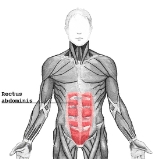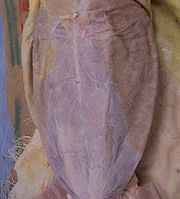
Rectus abdominis muscle
Encyclopedia
The rectus abdominis muscle, also known as the "six pack", is a paired muscle
running vertically on each side of the anterior wall of the human abdomen (and in some other animals). There are two parallel muscles, separated by a midline band of connective tissue called the linea alba (white line). It extends from the pubic symphysis
/pubic crest inferiorly to the xiphisternum/xiphoid process and lower costal cartilages (5–7) superiorly.
It is contained in the rectus sheath
.
The rectus is usually crossed by three fibrous bands linked by the tendinous intersections. While the "six pack" is by far the most common configuration of the muscle bellies of the rectus, there exist rare anatomic variations which result in the appearance of eight ("eight pack"), ten, or asymmetrically arranged segments. All these variations are functionally equivalent.
muscle. It is responsible for flexing the lumbar spine, as when doing a "crunch
". The rib cage is brought up to where the pelvis is when the pelvis is fixed, or the pelvis can be brought towards the rib cage (posterior pelvic tilt) when the rib cage is fixed, such as in a leg-hip raise. The two can also be brought together simultaneously when neither is fixed in space.
The rectus abdominis assists with breathing and plays an important role in respiration
in the event the patient is short of breath
. It also helps in keeping the internal organs intact and in creating intra-abdominal pressure, such as when exercising or lifting heavy weights, during forceful defecation or parturition (childbirth
).
and vein (or veins) run superiorly on the posterior surface of the rectus abdominis, enter the rectus fascia at the arcuate line
, and serve the lower part of the muscle. Second, the superior epigastric artery
, a terminal branch of the internal thoracic artery
, supplies blood to the upper portion. Finally, numerous small segmental contributions come from the lower six intercostal arteries as well.
.
The muscle is inserted by three portions of unequal size into the cartilages of the fifth, sixth, and seventh ribs.
The upper portion, attached principally to the cartilage of the fifth rib, usually has some fibers of insertion into the anterior extremity of the rib itself.
Some fibers are occasionally connected with the costoxiphoid ligaments
, and the side of the xiphoid process
.
 The rectus abdominis is similar in most vertebrates. The most obvious difference between animal and human abdominal musculature is that in animals, there are a different number of tendinous intersections.
The rectus abdominis is similar in most vertebrates. The most obvious difference between animal and human abdominal musculature is that in animals, there are a different number of tendinous intersections.
Muscle
Muscle is a contractile tissue of animals and is derived from the mesodermal layer of embryonic germ cells. Muscle cells contain contractile filaments that move past each other and change the size of the cell. They are classified as skeletal, cardiac, or smooth muscles. Their function is to...
running vertically on each side of the anterior wall of the human abdomen (and in some other animals). There are two parallel muscles, separated by a midline band of connective tissue called the linea alba (white line). It extends from the pubic symphysis
Pubic symphysis
The pubic symphysis or symphysis pubis is the midline cartilaginous joint uniting the superior rami of the left and right pubic bones. It is located anterior to the urinary bladder and superior to the external genitalia; for females it is above the vulva and for males it is above the penis...
/pubic crest inferiorly to the xiphisternum/xiphoid process and lower costal cartilages (5–7) superiorly.
It is contained in the rectus sheath
Rectus sheath
The Rectus sheath is formed by the aponeuroses of the Obliqui and Transversus. It contains the Rectus abdominis and Pyramidalis muscles.It can be divided into anterior and posterior laminae....
.
The rectus is usually crossed by three fibrous bands linked by the tendinous intersections. While the "six pack" is by far the most common configuration of the muscle bellies of the rectus, there exist rare anatomic variations which result in the appearance of eight ("eight pack"), ten, or asymmetrically arranged segments. All these variations are functionally equivalent.
Function
The rectus abdominis is an important posturalHuman position
Human positions refers to the different positions that the human body can take.There are several synonyms that refer to the human position, often used interchangeably, but having specific flavors....
muscle. It is responsible for flexing the lumbar spine, as when doing a "crunch
Crunch (exercise)
The crunch is one of the most common abdominal exercises. It primarily works the rectus abdominis muscle.-Form:A crunch begins with lying face up on the floor with knees bent. The movement begins by curling the shoulders towards the pelvis. The hands can be behind or beside the neck or crossed over...
". The rib cage is brought up to where the pelvis is when the pelvis is fixed, or the pelvis can be brought towards the rib cage (posterior pelvic tilt) when the rib cage is fixed, such as in a leg-hip raise. The two can also be brought together simultaneously when neither is fixed in space.
The rectus abdominis assists with breathing and plays an important role in respiration
Respiration (physiology)
'In physiology, respiration is defined as the transport of oxygen from the outside air to the cells within tissues, and the transport of carbon dioxide in the opposite direction...
in the event the patient is short of breath
Dyspnea
Dyspnea , shortness of breath , or air hunger, is the subjective symptom of breathlessness.It is a normal symptom of heavy exertion but becomes pathological if it occurs in unexpected situations...
. It also helps in keeping the internal organs intact and in creating intra-abdominal pressure, such as when exercising or lifting heavy weights, during forceful defecation or parturition (childbirth
Childbirth
Childbirth is the culmination of a human pregnancy or gestation period with the birth of one or more newborn infants from a woman's uterus...
).
Blood supply
The rectus abdominis has several sources of arterial blood supply. In reconstructive surgery terms, it is a Mathes and Nahai Type III muscle with two dominant pedicles. First, the inferior epigastric arteryInferior epigastric artery
In human anatomy, inferior epigastric artery refers to the artery that arises from the external iliac artery and anastomoses with the superior epigastric artery...
and vein (or veins) run superiorly on the posterior surface of the rectus abdominis, enter the rectus fascia at the arcuate line
Arcuate line (anterior abdominal wall)
The arcuate line of the abdomen, Linea semicircularis or Douglas' line is a horizontal line that demarcates the lower limit of the posterior layer of the rectus sheath. It is also where the inferior epigastric vessels perforate the rectus abdominus.Superior to the arcuate line, the internal oblique...
, and serve the lower part of the muscle. Second, the superior epigastric artery
Superior epigastric artery
In human anatomy, superior epigastric artery refers to a blood vessel that carries oxygenated blood and arises from the internal thoracic artery...
, a terminal branch of the internal thoracic artery
Internal thoracic artery
In human anatomy, the internal thoracic artery , previously known as the internal mammary artery , is an artery that supplies the anterior chest wall and the breasts...
, supplies blood to the upper portion. Finally, numerous small segmental contributions come from the lower six intercostal arteries as well.
Innervation
The muscles are innervated by thoracoabdominal nerves, which pierce the anterior layer of the rectus sheathRectus sheath
The Rectus sheath is formed by the aponeuroses of the Obliqui and Transversus. It contains the Rectus abdominis and Pyramidalis muscles.It can be divided into anterior and posterior laminae....
.
Location
The rectus abdominis is a long flat muscle, which extends along the whole length of the front of the abdomen, and is separated from its fellow of the opposite side by the linea alba.The muscle is inserted by three portions of unequal size into the cartilages of the fifth, sixth, and seventh ribs.
The upper portion, attached principally to the cartilage of the fifth rib, usually has some fibers of insertion into the anterior extremity of the rib itself.
Some fibers are occasionally connected with the costoxiphoid ligaments
Costoxiphoid ligaments
The Costoxiphoid Ligaments connect the anterior and posterior surfaces of the seventh costal cartilage, and sometimes those of the sixth, to the front and back of the xiphoid process....
, and the side of the xiphoid process
Xiphoid process
The xiphoid process, or xiphisternum or metasternum, is a small cartilaginous process of the lower part of the sternum which is usually ossified in the adult human. By age 15 to 29, the xiphoid usually fuses to the body of the sternum with a fibrous joint. Unlike the synovial articulation of major...
.
Damage
An abdominal muscle strain, also called a pulled abdominal muscle, is an injury to one of the muscles of the abdominal wall. A muscle strain occurs when the muscle is stretched too far. When this occurs the muscle fibers are torn. Most commonly, a strain causes microscopic tears within the muscle, but occasionally, in severe injuries, the muscle can rupture from its attachment.Animals


